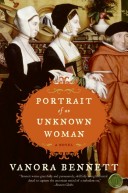
PORTRAIT OF AN UNKNOWN WOMAN
It is 1527. The English Renaissance is in full swing under the young King Henry VIII. The young German painter Hans Holbein, who has come to London to seek his fortune, is delighted when he gets a commission to paint the family of Thomas More, one of England’s leading statesman and men of learning, at his country home in Chelsea.
The story is seen through the eyes of More’s young ward Meg, and shows her growing feelings for her tutor, a man of mysterious background called John Clement, whom she will marry, and for Holbein himself, whom she will love.
It is 1527. The English Renaissance is in full swing under the young King Henry VIII. The young German painter Hans Holbein, who has come to London to seek his fortune, is delighted when he gets a commission to paint the family of Thomas More, one of England’s leading statesman and men of learning, at his country home in Chelsea.
The story is seen through the eyes of More’s young ward Meg, and shows her growing feelings for her tutor, a man of mysterious background called John Clement, whom she will marry, and for Holbein himself, whom she will love. This complex of emotions is played out against a backdrop of worsening religious intolerance in England and across Europe. More, a devout Catholic, abandons his old friendships with the humanists who have brought the Renaissance to England, and—to Meg’s growing horror—devote himself to hunting down Protestant heretics.
- Harper Paperbacks
- Paperback
- April 2008
- 464 Pages
- 9780061252563
About Vanora Bennett
Vanora Bennett is an award-winning journalist whose work has appeared in numerous publications, including the Los Angeles Times, The Times of London, and The Times Literary Supplement. She lives in north London.
Praise
Book Sense Pick
A Selection of Barnes & Noble’s Discover Great New Writers Program
“A journalist whose books include The Taste of Dreams: An Obsession with Russia and Caviar, Bennett proves equally adept at breathing life into a novel of the turbulent period of European history known as the Protestant Reformation. Bennett develops her characters fully by revealing both their romantic and their religious inner conflicts. With this interweaving of historical fact and imaginative characterization, she creates a multidimensional work of fiction. Readers of Tracy Chevalier’s Girl with a Pearl Earring will enjoy this debut novel for its elucidation of Holbein’s symbolism. Highly recommended.” —Library Journal, (starred review)
“Bennett … luminously shades in an ambiguous period with lavish strokes of humanity, unbridled passion and mystery.”—Publishers Weekly
“Meg is an appealing heroine for readers relishing a strong-willed, talented and intelligent protagonist who resists convention to ultimately find maturity and resolution of life’s trials. Bennett masters all the period details, intricate plotting, suspense, and characterization that make this debut novel a must have for those readers who like literary fiction with a large dose of historical authenticity.” —Booklist
“(An) ambitious, involving first novel … Bennett writes gracefully and persuasively, skillfully using historical details to capture the uncertain mood of a turbulent era. Her portrait of the artist Holbein and his work is fascinating, especially her explanation of the ingenious symbolism encoded in his second portrait of the More family. Meg may be the main character, but Holbein is the heart and soul of the story.”— Boston Globe
Discussion Questions
Could Meg Giggs be considered a “modern woman”? Why or why not?
Is it possible to fully understand the conflicts of an earlier age? What does it mean to learn from history?
Fathers and daughters—discuss this relationship and its manifestations in the novel. Has Meg and More’s relationship changed by the end?
What role does religion play in the novel?
Is there a “female” and a “male” side of medicine? Is there a difference between nursing and care given by physicians?
Holbein was one of the first painters to “see God in the human face” and paint works without religious subjects. Did art gain or lose by being decoupled from religious worship in the 16th century?
Does the smaller size of most families today, as opposed to the larger family structures of the 16th century, mean there’s less strife and sibling rivalry? Why or why not?
Can you lead an honest life if you’re harboring a secret?
Do you agree or disagree with Meg’s choices in the novel?
Does More deserve his fate?
